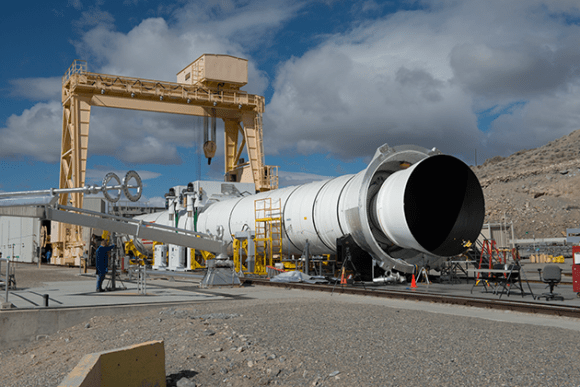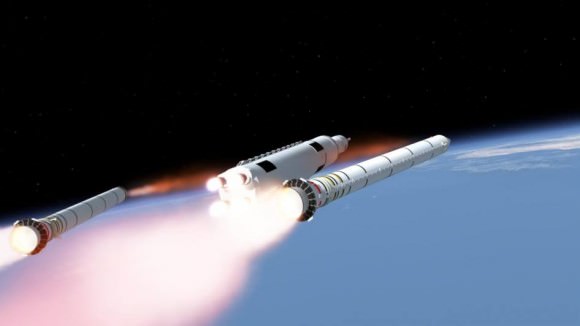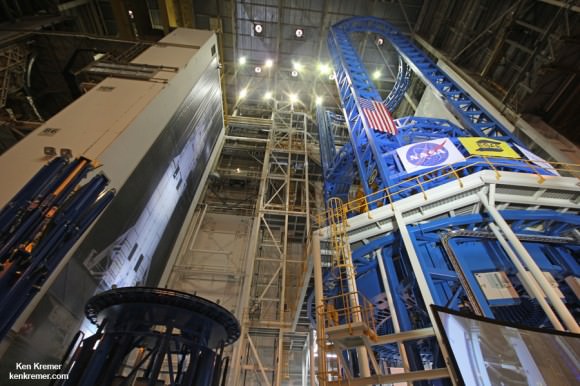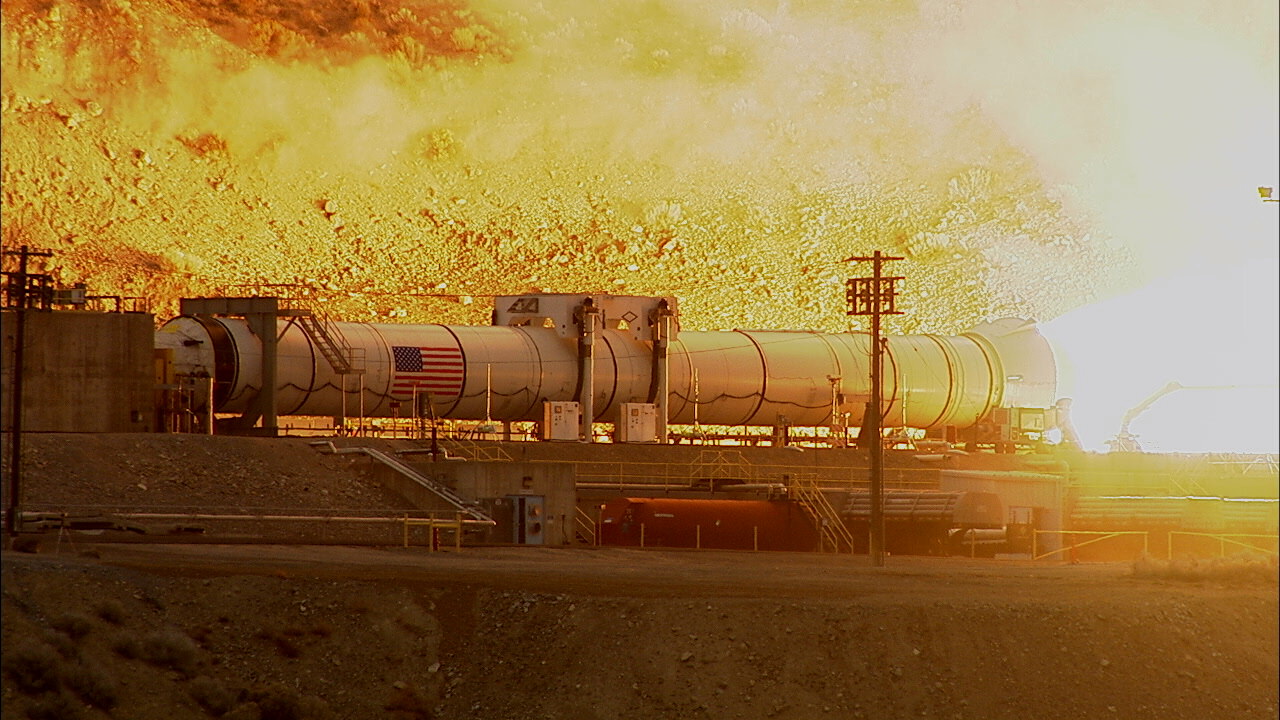At the Orbital ATK test facility, the booster for NASA’s Space Launch System rocket was fired for a two minute test on March 11. The test is one of two that will qualify the booster for flight before SLS begins carrying NASA’s Orion spacecraft and other potential payloads to deep space destinations. Image Credit: NASA
Watch the complete test firing video below[/caption]
KENNEDY SPACE CENTER, FL – NASA’s goal of sending humans back to deep space in the next decade advanced a major step forward today, March 11, with the successful ground test firing of the largest and most powerful solid rocket booster ever built that will be used to propel NASA’s Space Launch System (SLS) rocket and manned Orion spacecraft to destinations including the Moon, Asteroids and Mars.
The two minute long, full duration static test firing of the motor marked a major milestone in the ongoing development of NASA’s SLS booster, which is the most powerful rocket ever built in human history.
The booster known as qualification motor, QM-1, is the world’s largest solid rocket motor and was ignited at about 11:30 a.m. EST by prime contractor Orbital ATK at the newly merged firms test facility in Promontory, Utah.
Video caption: Space Launch System Booster Passes Major Ground Test on Mar. 11, 2015. The 5 segment solid rocket booster being developed for the SLS rocket fired for two minutes, the same amount of time it will fire when it lifts the SLS off the launch pad, and produced about 3.6 million pounds of thrust. The test was conducted at the Promontory, Utah test facility of commercial partner Orbital ATK. Credit: NASA
It burned for exactly the same amount of time as it will during flights of the SLS booster which will lift off from Launch Complex 39B at the Kennedy Space Center in Florida.
The booster test firing was the second of two major do or die tests conducted by NASA in the past three months in support of the agency’s “Journey to Mars” strategy to develop the infrastructure required to send astronauts to an asteroid in the next decade and beyond to the Red Planet in the 2030s.
“The work being done around the country today to build SLS is laying a solid foundation for future exploration missions, and these missions will enable us to pioneer far into the solar system,” said William Gerstenmaier, NASA’s associate administrator for human exploration and operations, in a statement.
“The teams are doing tremendous work to develop what will be a national asset for human exploration and potential science missions.”

where it is being conditioned for the March 11 ground test. Credit: Orbital ATK
The 5-segment booster produces 3.6 million lbs of maximum thrust which equates to more than 14 Boeing 747-400s at full takeoff power!
The new 5-segment booster was derived from the 4-segment booster used during NASA’s three decade long Space Shuttle program. One segment has been added and therefore the new, longer and more powerful booster must be requalified to launch the SLS and humans.
A second test is planned a year from now and will qualify the boosters for use with the SLS.
“This test is a significant milestone for SLS and follows years of development,” said Todd May, SLS program manager.
“Our partnership with Orbital ATK and more than 500 suppliers across the country is keeping us on the path to building the most powerful rocket in the world.”

The QM-1 booster weighs in at 1.6 million pounds and required several month of conditioning to heat to the 90 degrees temperature required to conduct the static fire test and thereby qualify the booster design for high temperature launch conditions. It was mounted horizontally in the test stand and measured 154 feet in length and 12 feet in diameter and weighs 801 tons.
Temperatures inside the booster exceeded over 5,600 degrees F.
The static fire test was exquisitely planned to collect data on 103 design objectives as measured through more than 534 instrumentation channels on the booster as it was firing.
The second booster test in March 2016 will be conducted to qualify the propellant temperature range at the lower end of the launch conditions at 40 degrees F.
The first stage of the SLS will be powered by a pair of the five-segment boosters and four RS-25 engines that will generate a combined 8.4 million pounds of liftoff thrust.
The maiden test flight of the SLS is targeted for no later than November 2018 and will be configured in its initial 70-metric-ton (77-ton) version with a liftoff thrust of 8.4 million pounds. It will boost an unmanned Orion on an approximately three week long test flight beyond the Moon and back.
NASA plans to gradually upgrade the SLS to achieve an unprecedented lift capability of 130 metric tons (143 tons), enabling the more distant missions even farther into our solar system.
The first SLS test flight with the uncrewed Orion is called Exploration Mission-1 (EM-1) and will launch from Launch Complex 39-B at the Kennedy Space Center.

Orion’s inaugural mission dubbed Exploration Flight Test-1 (EFT) was successfully launched on a flawless flight on Dec. 5, 2014 atop a United Launch Alliance Delta IV Heavy rocket Space Launch Complex 37 (SLC-37) at Cape Canaveral Air Force Station in Florida.
Orion’s inaugural mission dubbed Exploration Flight Test-1 (EFT) was successfully launched on a flawless flight on Dec. 5, 2014 atop a United Launch Alliance Delta IV Heavy rocket Space Launch Complex 37 (SLC-37) at Cape Canaveral Air Force Station in Florida.

Stay tuned here for Ken’s continuing Earth and Planetary science and human spaceflight news.
Ken Kremer
. ………….
Learn more about MMS, Mars rovers, Orion, SpaceX, Antares, NASA missions and more at Ken’s upcoming outreach events:
Mar 11: “MMS, Orion, SpaceX, Antares, Curiosity Explores Mars,” Kennedy Space Center Quality Inn, Titusville, FL, evenings


Yeah, back to the 1970’s, this is the way forward! Use old tech, but reengineer everything so that it becomes exorbitantly expensive and never will be used. In the storm of criticism against the SLS, I’ve never seen anyone predict any kind of technical malfunction. It will certainly tick like a clock. The problems are instead on a more abstract economical and political level. This thing won’t be part of human exploration of space.
It is not important if it flies or not.
* It creates jobs in the US
* The money is used to pay American people.
* The US increases in technological knowledge.
* Patented technologies brings in more money for the America,n people.
Jobs are never “created”. Job is consumption. Those skilled people now wasting their time on the SLS, which will never fly, could’ve created something useful instead. Now their competence and time has been wasted for no good. And reinventing 1970’s rocket tech is not helpful for space exploration. SLS is a muppet show. (I hope you are ironic, Olaf, that is always very difficult to tell in text).
As exciting as this appears to be, there is one major problem. Each of these test do more environmental damage than a big city like Hong Kong, does in an entire year. There is air pollution, contribution to global climate change, and a waste of the fossil fuel supply in the Earth. Our great-great-grandchildren will wonder if any of this was worth it as they gasp for air to breathe and forage for food to eat in the wasteland’s of the remaining habitable areas. Humans have less than 100 years to live. That is a fact. We got to find a solution. Even the best case scenarios are 300 years. After that it will just be cockroaches, ants, and a few spiders remaining on the surface of the Earth, until the next cosmic event starts a new eon.
Your uneducated doomsday propaganda is hilarious! You lie that humanity only has 100 years to live. You are fooled to “believe” that because some lier in a silly black dress told you so. And referred to a ridiculous book written thousands of years ago. You are stoopid enough to buy that fraud!
And fossil fuels, terrorism, global warming and on and on you doomsday believers mumble your mantra without using any information or applying any logic. You’ve done so for a thousand years. And then another thousand years. And another thousand years, we’ve heard you many times before. You have always failed. You have always been wrong. You have never learned anything. Why don’t you kill yourself? Why don’t you create your own doomsday for yourself. Please!
Thanks F.A.L.O. for your direct words… so I don’t have to say this. But… on the other hand… if we don’t change the course of our steamer… we’re pretty close to the cliffs named “religious fanatics”, global warming (with all that comes along with it like sea level-rise…) and those which still have no name.
But I am the last optimist standing… if we all seriously try to stay out of harms way…. we’ll make it!
Terrorism and war is almost exclusively a problem for the Arab World, not for humanity as a whole. And the temperature has not increased since the late 1990’s, the doomsday has been canceled once again…
If you examined the data a bit more closely, you’d find out that the ocean temperature has been rising quickly during that time. Energy will always flow to the “easiest” place it can get to, and for the past few years that’s been the deep oceans. The temperature rise has been dramatic, and is playing havoc with life in the seas.
Your argument is invalid.
http://i2.kym-cdn.com/photos/images/original/000/061/297/nickcage.jpeg
Your argument is invalid
Besides that, this test burns 600 metric tons of propellant. Most propellant is converted to energy during combustion. Conservatively perhaps 1% remains uncombusted – about 6 tons max. Compare that to large countries who’s annual CO2 output is measured in billions of tons. Space exploration provides modern society opportunity to advance.
Having said all that I am opposed to the use of aluminum perchlorate in the solid fuel which is highly toxic to humans, animals and the environment.
I am bewildered that NASAs research into parafin/lox hybrid boosters which put out more specific impulse thrust with almost no environmental impact are being sidelined for political expediency.
One more time
http://science.nasa.gov/science-news/science-at-nasa/2003/28jan_envirorocket/
The world’s biggest firework – pity they couldn’t hook some big piezo crystals up and generate power from the test.
This may currently be the most powerful solid rocket booster, but it’s not the most powerful ever – Aerojet tested one in the 1960’s that developed over 5,000,000 pounds of thrust: http://ntrs.nasa.gov/archive/nasa/casi.ntrs.nasa.gov/20000033816.pdf .
So.. strap on a couple Constellation era solid rocket boosters and get on up! Tell me.. aren’t there a new breed of solid rocket fuels being tested? Those fuels allow shutting down the engine (re-ingnition too?) unlike other solids. That would be a MAJOR milestone! Burns cleaner, parafin based with an HO oxidizer?
Those are hybrids, not true solids. They have pretty extreme safety concerns attached to them, too.